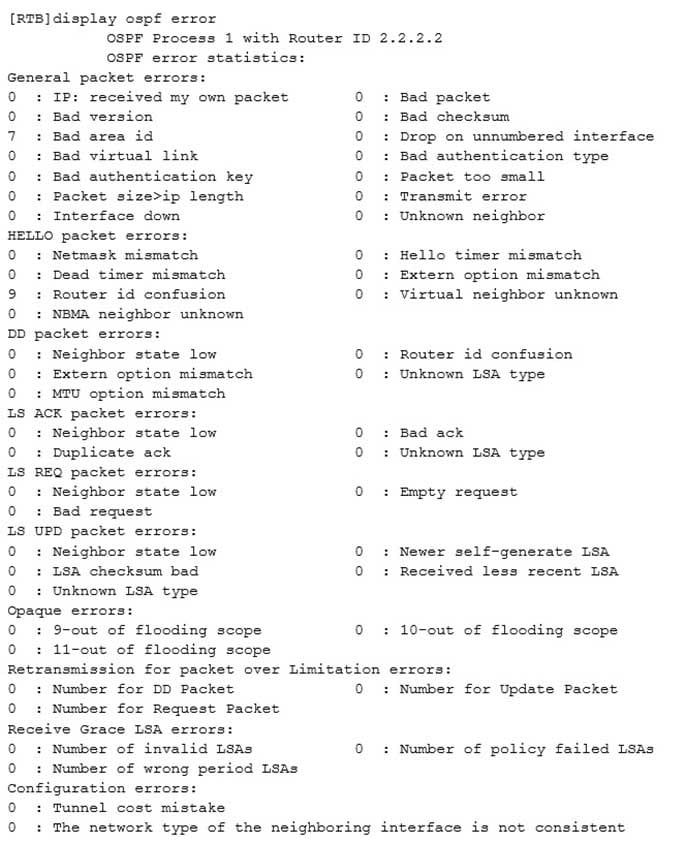H12-224 : HCNP-R&S Fast Track (Huawei Certified Network Professional – Routing & Switching Fast Track) : Part 17
-
For a network like 175.25.128.0/19, the mask value is?
- 255.255.0.0
- 255.255.224.0
- 255.255.24.0
- Different based on the address type
-
Which of the following statements about Stub areas is false?
- An AS-external-LSA cannot be advertised to a Stub area.
- The ABR in the Stub area generates a default route to guide forwarding of packets destined for other areas.
- A Transit area cannot be configured as a Stub area.
- Any area can be configured as a Stub area.
-
If the network address 172.29.100.0/16 is subnetted, which of the following valid VLSM subnets can be obtained?
- 172.29.100.8/28
- 172.29.100.32/28
- 172.29.100.60/28
- 172.29.100.104/28
-
Which of the followings are OSPF packet type? (Choose three.)
- LSA
- LS Request
- LSP
- LS Update
- LS Ack
-
The IP address 0.0.0.0 indicates ().
- Network address
- Broadcast address of specially designated network segment
- All networks
- Broadcast address of all nodes of local network segment
-
What is the link ID of an ASBR-Summary-LSA?
- OSPF Router ID of an LSA’s originator
- Port IP address of the DR on the described network segment
- Address of the destination network segment
- Router ID of the destination ASBR
-
When the GR Restarter performs the active/standby switchover, the neighbor performs which of the following operations when detecting that a TCP disconnection? (Choose three.)
- Keeping the routing tables of various address families advertised by the GR Restarter during negotiation, marking entries in these tables with stale tags, and starting a stale timer
- Starting a restart timer.
- Clearing all routing entries and forwarding entries related to the GR restarter if the GR restarter fails to re-establish the BGP connection with the neighbor after the restart timer expires.
- Remaining the neighbor relationship unchanged.
-
On a broadcast network or an NBMA network, not all neighbors need to set up adjacencies. Therefore, the concept about the adjacency is applicable to only the broadcast network or the NBMA network.
- True
- False
-
Which is the default network mask length of 219.25.23.56?
- 8
- 16
- 24
- 32
-
If both the ospf cost and bandwidth-reference commands are configured on an interface, the value set in the ospf cost command is used as the cost of the interface.
- True
- False
-
The vlink-peer command is used to specify a peer IP address for setting up a virtual link.
- True
- False
-
The bandwidth-reference parameter is measured in Mbit/s.
- True
- False
-
Which of the following statements about BFD are true? (Choose three.)
- It cannot be used to detect MPLS networks.
- It provides low-load and short-duration detection for paths between adjacent forwarding engines.
- It provides a unified mechanism for detecting all types of media and BFD-supporting protocols.
- It is a bidirectional detection mechanism.
-
Which of the following statements about the Monitor Link group is false?
- A Monitor Link group has uplink and downlink interfaces.
- A Monitor Link group has one uplink interface and several downlink interfaces.
- In a Monitor Link group, the status of the downlink interface changes in accordance with the status of the uplink interface.
- The Smart Link group can only serve as a downslink interface.
-
An OSPF neighbor relationship fails to be established and the display ospf error command output is as follows.

H12-224 HCNP-R&S Fast Track (Huawei Certified Network Professional – Routing & Switching Fast Track) Part 17 Q15 020 Which of the following is the probable cause?
- Router IDs conflict.
- Area IDs are mismatched.
- Network masks are inconsistent.
- Authentication types are inconsistent.
-
A network administrator needs to construct a small-scale network containing only 22 hosts and the ISP assigns only one public IP address as the egress address. Which of the following addresses can be used by the network administrator to plan the network?
- 10.11.12.16/28
- 172.31.255.128/27
- 192.168.1.0/28
- 209.165.202.128/27
-
Which of the following statements about state transition are true? (Choose three.)
- The neighbor state machine transitions from the Loading state to the Full state if a LoadingDone event occurs.
- The neighbor state machine transitions from the Exstart state to the Full state if a NegotiationDone event occurs.
- The neighbor state machine transitions from the Exchange state to the Full state if an ExchangeDone event occurs.
- The neighbor state machine transitions from the Exchange state to the Loading state if an ExchangeDone event occurs.
-
On a non-broadcast network, OSPF has two operating modes: NBMA and P2MP.
- True
- False
-
The most remarkable characteristic of OSPF is that OSPF supports the link-state algorithm.
- True
- False
-
The ABR in a Totally Stubby area will not advertise Type-3, Type-4, and Type-5 LSAs to the Totally Stubby area. Instead, the ABR will advertise a default route to the Totally Stubby area to guide forwarding of packets destined for other areas.
- True
- False
Subscribe
0 Comments
Newest